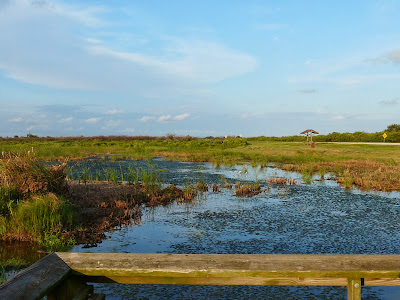Oliver caught all kinds of fish. Here he is showing off one of the many black drums he pulled in.
Bastrop Bayou Pier also offers several car pull-ups where you can do some bank fishing. We spent time in this area as well, depending on our mood.
Another popular sport in this part of the Coast is crabbing. We tried it and had some success. Here are our first two catches (Blue Crabs), which we enjoyed as part of that night's dinner. Yum!
Brazoria Natonal Wildlife Refuge was founded in 1966 to provide a wintering habitat for migratory waterfowl and other bird species, serving as an end point for the ducks and geese migrating south along the Central Flyway for the winter. It is also an entry point for neotropical migratory songbirds headed north to their breeding grounds, tired from their 600-mile crossing of the Gulf of Mexico.
This is the beginning of the refuge drive loop. We spent time here frequently to look the birds feeding in these waters and also to check out the resident alligator family (more photos to come).
This beauty lives on the refuge and we saw her frequently.
From Brazoria's webpage: " Here, freshwater sloughs wind through salt marshes and rare, native bluestem prairie graces the upland areas. For wildlife, the expanse of salt and freshwater marshes, sloughs, ponds, woody thickets and coastal prairies provide a place to rest, nest and feed. For people, these vestiges of wild Texas offer respite from the concrete jungle, a glimpse of the landscape as it looked before human settlement."
 |
 These brackish wetlands serve as nurseries, supporting shellfish and fin fish, important sources of food for many species. |
This is a native Texas wildflower called "Snow on Prairie". We had never seen this plant and it was everywhere. The white accents along its petals really stands out among all of the green fields.
Above is the Texas Lantana, a flower that grows in all types of soil and attracts butterflies. You see this pretty plant all around this area. At the end of this post is a pinkish lantana that was growing wild along the road between our house and the fishing pier.
If you look real close, you can see what Oliver called "minis", baby alligators who lived with their mamma in the backwaters of the refuge. We thought they were adorable and so small. Mamma was never too far away, and of course, you never get too close to a baby alligator whose mom is watching. We observed them from a safe distance (thank goodness for the telephoto lens!).
"It is because of its strategic location on the Texas Gulf Coast that the refuge supports an incredible diversity of wildlife. Mild temperatures, fresh and salt water estuaries, bay waters and a blend of soils are a few of the factors that have created this rich habitat and
home to many wildlife species: 400 species of birds, 95 species of reptiles,
130 species of butterflies and dragonflies."
This is where we lived. It is a very comfortable three bedroom home.
Here are some of the sweeping views we had from our house. We just loved it and marveled in the natural beauty and all of the terrific water sports available in this area.
Above is the view from the bridge looking down at the Bastrop Bayou Fishing Pier. To the far left (just beyond the edge of this photo) is the refuge housing area where we lived.
Above is the view of our house, from Bastrop Bayou Pier.
This is the complex office where we did most of our work. Oliver spent some time working at the San Bernard Field office while I was away visiting Madison during her semester abroad. He captured a lot of good history there and also enjoyed his time with the staff there.
The "back yard" of the complex office. This was the view we had from our work station.
Here I am with Jennifer, a biologist for the complex. She is a wealth of info on the local wildlife and gave us some great suggestions on places to fish and crab. Below Oliver is with Mike, a biologist-turned real estate guru, growing the acreage/size of the lands protected by the refuge over the past decade. We enjoyed talking with them both and appreciate their personal interest and passion for their work and for the area. The entire staff at Brazoria was helpful and welcoming. It was the perfect place for us to land before, during and after the govt. shut-down.
The Fire Crew ran a prescribed burn during our visit. This was on the San Bernard Refuge, but visible from the Complex Office. We actually drove closer to the edge of the fire for a better look. We were amazed by the precision involved in this effort and also appreciate that these fires help manage the plants and grounds, ridding the burned area of invasive species and overgrown brush.
We can end this post with photos of some of the many beautiful images we enjoyed during our extended visit at the Texas Mid-Coast Refuge Complex. You can learn and see more at their website: http://www.fws.gov/refuge/brazoria/










































































































































